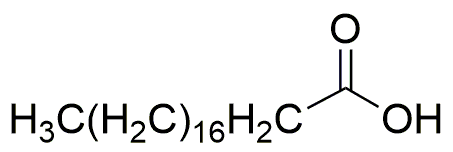Nonadecanoic acid is widely utilized in research focused on:
- Food Industry: It serves as a flavoring agent and preservative in various food products, enhancing taste and extending shelf life.
- Cosmetics: This fatty acid is incorporated into skincare formulations for its emollient properties, helping to moisturize and soften the skin.
- Biotechnology: It is used in the production of biodiesel, providing a renewable energy source that can reduce reliance on fossil fuels.
- Pharmaceuticals: Nonadecanoic acid acts as a building block in the synthesis of certain drugs, contributing to the development of new therapeutic agents.
- Surfactants: It plays a role in the formulation of detergents and cleaning products, improving their effectiveness in removing dirt and grease.
General Information
Properties
Safety and Regulations
Applications
Nonadecanoic acid is widely utilized in research focused on:
- Food Industry: It serves as a flavoring agent and preservative in various food products, enhancing taste and extending shelf life.
- Cosmetics: This fatty acid is incorporated into skincare formulations for its emollient properties, helping to moisturize and soften the skin.
- Biotechnology: It is used in the production of biodiesel, providing a renewable energy source that can reduce reliance on fossil fuels.
- Pharmaceuticals: Nonadecanoic acid acts as a building block in the synthesis of certain drugs, contributing to the development of new therapeutic agents.
- Surfactants: It plays a role in the formulation of detergents and cleaning products, improving their effectiveness in removing dirt and grease.
Documents
Safety Data Sheets (SDS)
The SDS provides comprehensive safety information on handling, storage, and disposal of the product.
Product Specification (PS)
The PS provides a comprehensive breakdown of the product’s properties, including chemical composition, physical state, purity, and storage requirements. It also details acceptable quality ranges and the product's intended applications.
Certificates of Analysis (COA)
Search for Certificates of Analysis (COA) by entering the products Lot Number. Lot and Batch Numbers can be found on a product’s label following the words ‘Lot’ or ‘Batch’.
*Catalog Number
*Lot Number
Certificates Of Origin (COO)
This COO confirms the country where the product was manufactured, and also details the materials and components used in it and whether it is derived from natural, synthetic, or other specific sources. This certificate may be required for customs, trade, and regulatory compliance.
*Catalog Number
*Lot Number
Safety Data Sheets (SDS)
The SDS provides comprehensive safety information on handling, storage, and disposal of the product.
DownloadProduct Specification (PS)
The PS provides a comprehensive breakdown of the product’s properties, including chemical composition, physical state, purity, and storage requirements. It also details acceptable quality ranges and the product's intended applications.
DownloadCertificates of Analysis (COA)
Search for Certificates of Analysis (COA) by entering the products Lot Number. Lot and Batch Numbers can be found on a product’s label following the words ‘Lot’ or ‘Batch’.
*Catalog Number
*Lot Number
Certificates Of Origin (COO)
This COO confirms the country where the product was manufactured, and also details the materials and components used in it and whether it is derived from natural, synthetic, or other specific sources. This certificate may be required for customs, trade, and regulatory compliance.

